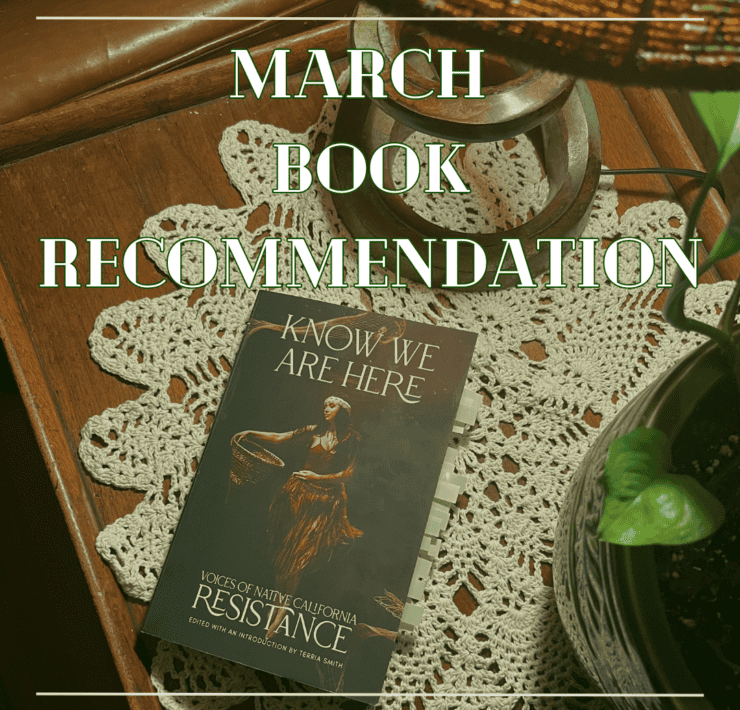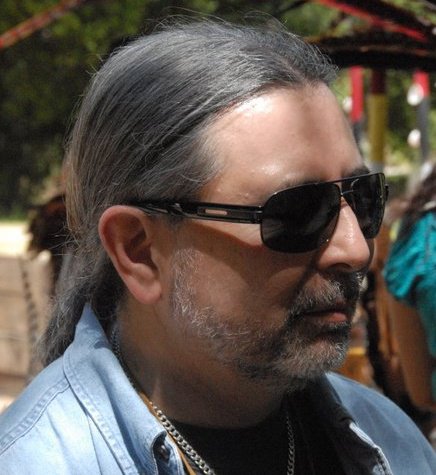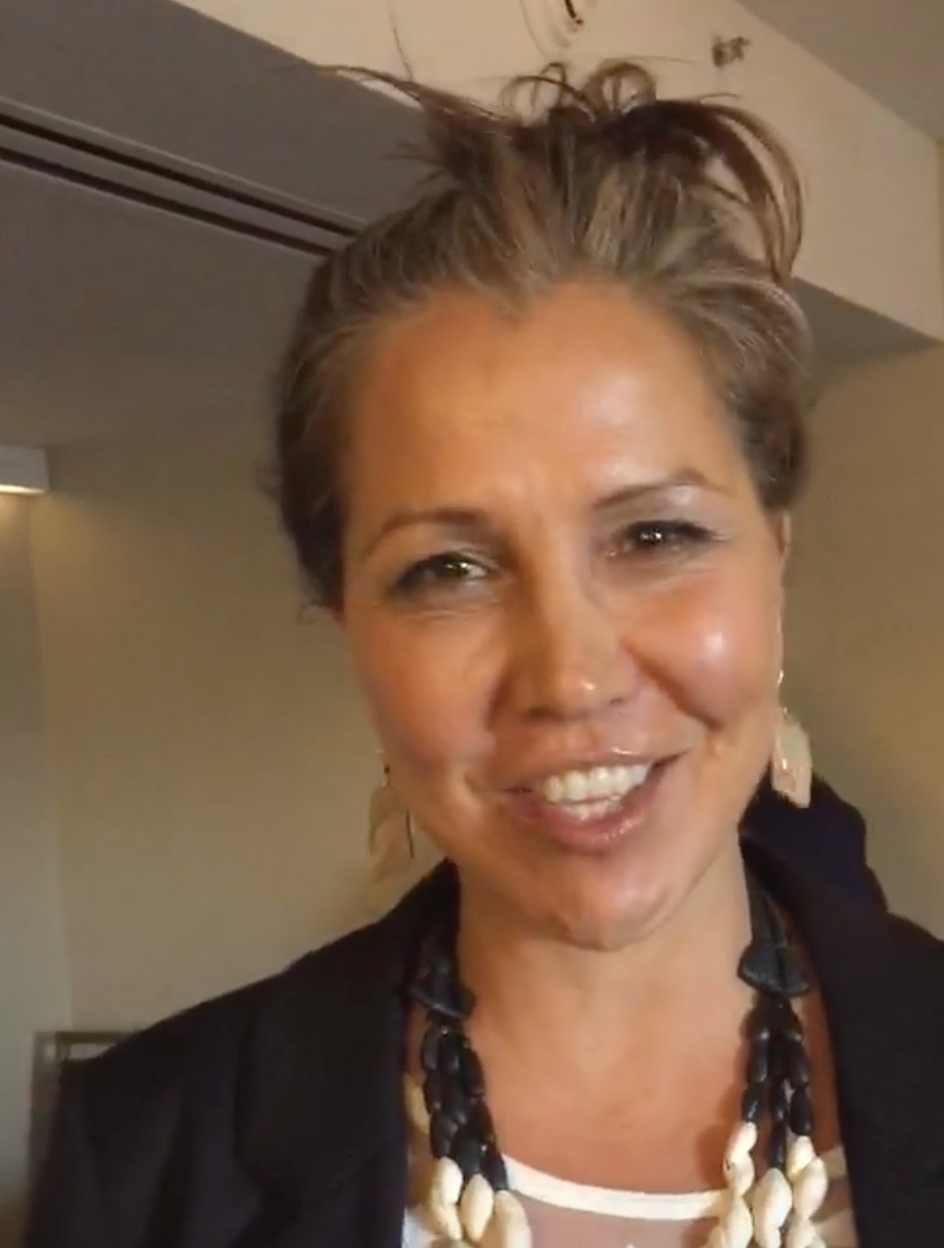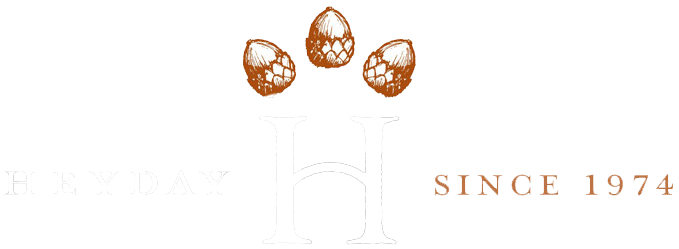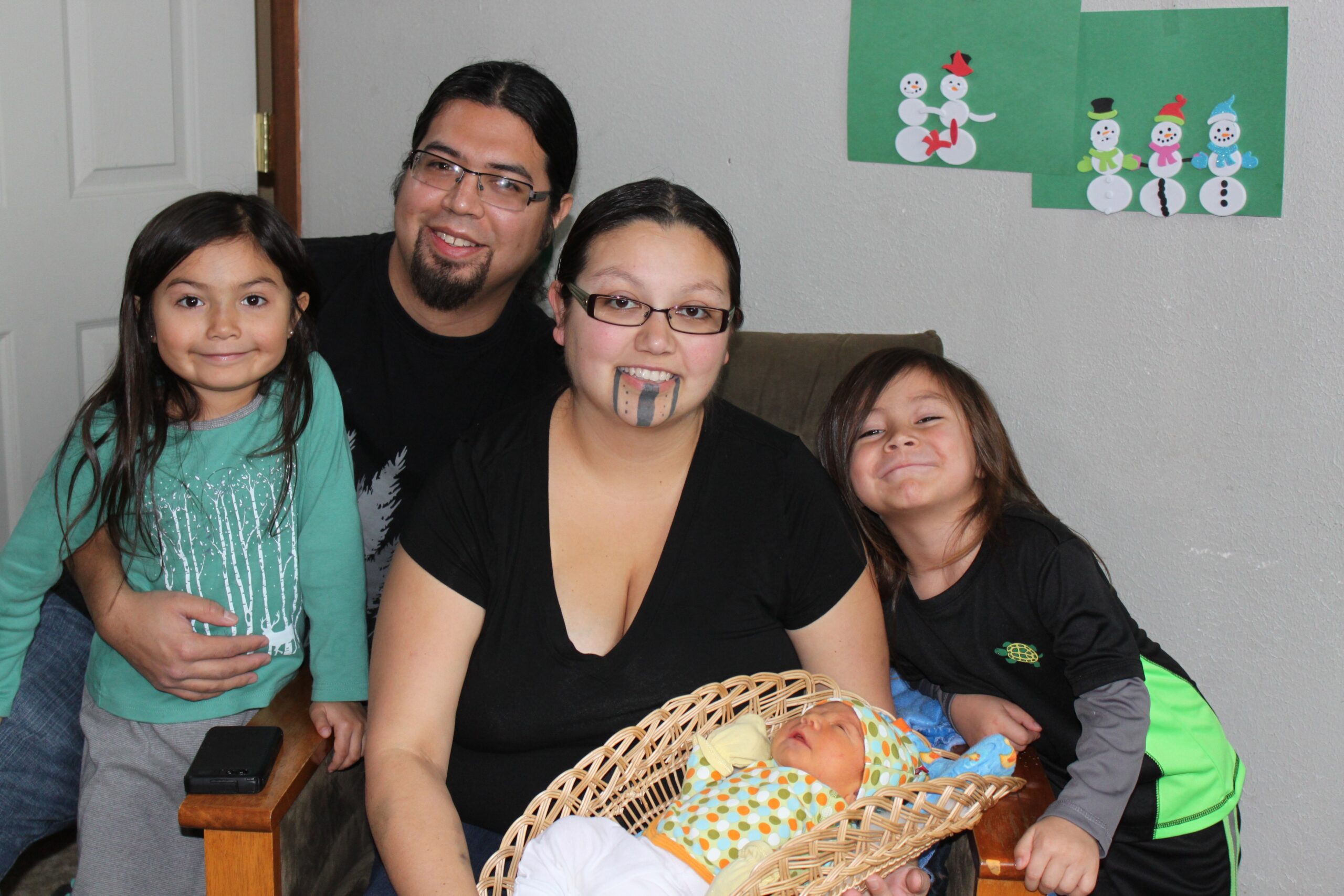
Heartbeats of the Language: Home-schooling in Tolowa
This is an interview with Ruby Tuttle Bommelyn (Yuki Maidu, Karuk, Yurok) March 20, 2014, at a master-apprentice training of Advocates for Indigenous California Language Survival (AICLS). Mickey Ellinger was the interviewer. Ruby is married to Pyuwa Bommelyn, a member of the Tolowa Tribe, and is home-schooling their children in the Tolowa language. The Tolowa are from northern Del Norte County into southern Oregon, Wilson Creek, Sixies River up to Applegate River.
When I found out I was pregnant my husband, Pyuwa, and I made the conscious decision to speak Dee-ni Wee-ya’ with our child.
When I found out I was pregnant I started learning the language. As our daughter grew and we added San-t’as, our son to the mix, we realized that as soon as we sent them to school, their level of language input would drop dramatically.
We realized that once Hune goes to school, she won’t speak the language any more. It won’t be of value to her because none of her friends will speak the language. We want her to be out there and have friends. But we also want her to value the language as an important way of communicating.
It’s vital that the kids learn the language to become the next speakers. There’s only one speaker and we have to have speakers, If we have no speakers then the language dies. Pyuwa comes from a dance family, we put on the ceremonies, and it’s that much more important that the kids know the language, because someday that will be their dance. Someday they will be the ones having to say the prayers, sing all of the songs and make medicine in the language. They could do it in English, I guess, but it just wouldn’t be as powerful. It’s going to be theirs one day. So we have to figure out how they’re going to know it. And the only way they’re going to know it is by learning.
If you look at it like a heart monitor, the language is flatlining right now. But every time we get the kids to speak it’s like another heartbeat for the language. We’re creating these heartbeats in hopes that the language will be alive again.
We met these two wonderful people from Hawaii, Kauanoe and Pila. Kauanoe started the Hawaiian immersion school in her home with her children. She started with three kids in her home, and that’s how she started her school, because she wanted her kids to speak Hawaiian. It all started from those three kids in that home.
Once we realized that when Hune goes to school she’s not going to speak any more, we said, well, why don’t we do that. So we took Hune out of preschool up at the University of Oregon. We said we’re going to do preschool at home,, we’re going to do it in the language. And we did. Then we said, OK, it’s time for kindergarten, what do you have to do in kindergarten? What are the math standards, what are the language arts standards, the science? We started figuring all that out and figuring out what we needed to do.
Choosing Literacy
We had to make a choice; do we want to teach literacy or do we want to wait? How’s that going to work? No child has intentionally been taught to learn the language before. Even where there were fluent speakers, no one was reading and writing the language, they were only speaking it, it was only oral.
We decided that, yes, she will need to learn how to be literate in the language, so we started that process, teaching all the letters in the language, and then teaching her how to find initial sounds, all the basic steps of reading and everything they do in kindergarten is what we’re doing with her now.
I’m already starting to look at all the first grade standards and starting to write that curriculum for the first couple months of the first grade year.
Pyuwa grew up hearing the language, because his dad speaks. But he didn’t retain the language because there wasn’t time specifically dedicated to language use in the family. He grew into a passive speaker rather then an active language user. He was getting this idea that maybe he should work on the language, or maybe it’s time to start doing this, and then he happened to be in a plane crash, and he almost died. It was a horrific experience.
He came out of that experience saying, “I need to speak my language.” That’s when he started, the year before we were married. He started seriously learning language a couple of years before I did.
I started learning in class; I took Loren Bommelyn’s class for two years and then Pyuwa started teaching the class and I took their class. Then we started learning in the home and Pyuwa was doing the master-apprentice program with his dad, and transliterating the dictionary from the old orthography to the new. Then Pyuwa decided he would go get his masters in language teaching specialization at the University of Oregon. So we moved up there and then he has taught Tolowa at the university, and I took those classes.
Then we started working at home. We were always doing stuff with the kids, and that’s what really drove me, wanting to do stuff with the kids, so i’d find out the language I needed to talk to them. At one point I could say a lot to the kids, but I couldn’t really talk to any adults. “What are you playing with? Do you have a wet diaper?”
A typical day of home school
We teach both the kids together; they are a year apart, five and four now. Because Hune’s so young, to get all the way through an entire lesson of teaching something particular, it will often take one or two days. We sing the alphabet to start our day. We are lucky enough to have a big enough house that we can dedicate one whole room to home school. All along the ceiling there’s the alphabet. My dad, Frank Tuttle, was gracious enough to draw all the pictures that we needed. Lots of them are culturally relevant pictures because that’s what we need.
We have a number song, so then we sing that, and they practice touching all the syllables as they sing the words, which is great, because it’s teaching them to recognize that the word that they are saying – like lha’ naa-xe taa-xe – and that’s neat. We also have a mural on one of our walls. Well, we call it a mural. We made some mountains and we made a lake. Every day at the end of our lesson the kids have a worksheet and it will have some kind of animal or something on it, a picture my dad drew. They color it in, cut it out and glue it up there. That’s the word that they’re required to remember for the next day. It’s full; our mural’s getting kind of overflowing. We may need to add some more land mass. We go through and they name all the animals on there. Tee-la~… Everything they do they touch, so they get that muscle connection, that physicalness. It’s the same kind of thing as in ASLA (accelerated second language acquisition) where you touch everything, and it helps you remember.
The next thing we do is – all of those letters that we’ve worked on for the whole year – we’re almost through the whole alphabet – they go through and like hv haa-chu mv mee-k’vm – and they are able to say what the letter is and what the word is that goes with that letter – and that’s helping them with their sight reading and helping them to recognize their sounds. That takes about half an hour, that’s how we warm up and get ready to do our day.
And then we start with letters. We have a letter of the day. The first day we do the upper case and the second day we do the lower case. We introduce the letter; we do it all in the language. So say the letter was M. So “Dii M” and then I draw it out. Then we play some kind of game where they have to find the M. I’ll have a bunch of letter cards out on the table and they’ll have to flip it over and find what they’re looking for. I’ll say a letter, like H, and then they’ll have to find it. Or if it’s on the whiteboard then they erase that one. That helps them to recognize that, oh, they already know all of these letters, and we’re just introducing the one new one.
Then we’ll do some kind of activities where they have to recognize the letter in words. We’re lucky enough to work with my mom, who has been a teacher for 30 years, a reading specialist, so having her help us with the literacy curriculum is amazing. She’s helped us come up with a set of lessons that will take a month. And then after that we just recycle. We have picture cards for all the words. For every letter that they learn, they have three nouns that they also will learn as sight words. There are pictures, like tee-la~ tee-ma, I forget – so we go over those and pick those out. Sometimes we do bowling, and they have to be able to name the animal and the initial sound of that animal’s name, and then they can bowl that one pin down. Or we play detective and they have magnifying glasses, and I hide letters or I’ll hide pictures around the room and they have to go look at each one and be able to figure out in their heads but also to be able to say out loud what the picture is and what the initial sounds are, what the ending sound is. So we play different kinds of games. We do a phonemic exercises every day.
Then we go into math, which usually takes about an hour. With math we use the Scott Foresman, a math homeschool program you can buy, and we do it all in the language. We don’t use the pages that have a lot of English on them. I’ll make a page in Power Point that will kind of mimic it. If it has so much English on the page, I don’t want to have to be “what’s that word mom”, “dii day-la?’”…”let’s not say that right now,” I just substitute it out for something else, and that way I don’t have to create a math curriculum, because i just don’t have the time.
Language Arts Curriculum
I already have to create the whole language arts curriculum. There are six parts to it. There’s an introduction, a beginning writing portion where you go over how you write the letter, and then there are a couple of phonemic exercises, where they go over that sound, h, h, and find it in different things. Then we do some sight words, so they’re reading shorter words. Say the word is chaa~ which is to eat. They’ve already learned bird, bear, eagle, cat, they’ve already learned those things.
Then I’ll have a little book made up. They have to fold it and staple it to give them that value. I realized that if mom does it, they get ruined, but if they put the time and energy into it, then it’s their book, and so they take good care of it. So they get the book. Then they have to read it. They already recognize the picture of the animal and then they have their sight words, like Buu-sri chaa~.; Tee-la~ chaa~; so then they read with the sight words that we’ve gone over. They are able to read these 8 page little books, repetitive books. They love being able to read books, they’re so proud of themselves all the time. That will take about an hour and a half for us to get through that.
We have a theme that will run for about two weeks. We’ve done butterfly life cycles, land mass, things you do on a farm. During winter solstice we did winter stories, stories you only tell in the winter time. We’ve talked about different kinds of animals. That’s like a running theme through everything. And then we’ll do some kind of craft. And by then it’s like 2:30, 3 o’clock. We’re off to gymnastics or ballet or music. And that’s our day.
What Works, What Doesn’t
We’ve been doing it almost two years. I do lots of informal assessment as we’re working on stuff, like “Show me where the bear is.” If they can’t tell me where the bear is, we go back and repeat. Or “What does that start with, lha’. what’s the first sound in that?” And if they can’t figure it out we’ll go back and repeat. We found there are lots of exercises that don’t work very well, and some that do, some that are great. We’ve also learned about time, how much time you can spend working on one thing before you have to take a break.
Sometimes we find these really great ideas on line and they just don’t work for our indigenous language. I don’t know if it’s because we have lots of consonants in our language or maybe it’s because our language just hasn’t been studied very much that lots of things that will work for English language learners we try to do them and … that really didn’t work out. or …was it supposed to be like that?
We’ve run up against a lot of roadblocks. Math was a big one in the beginning, because I wanted to be able to do my own math curriculum, so I tried. And I’d work at it. But then, after the kids go to bed, I’d wash dishes, do laundry, straighten up the house a little bit, and make curriculum for tomorrow. It was really a stressful time for about a month a half. I was creating what we were going to do the next day the night before.
I said I can’t keep doing this. I have to figure this out. So we took a vacation, off for a week. I said I’m going to do a bunch of these lessons at the beginning of the week, and then i’ll have them, and that’s when i just broke down and bought a curriculum and used that to teach.
Expense is the other thing we run up against a lot – we’re not funded – it’s just us. People think we’re funded through these language programs or language departments, and it’s no, it’s just us, my husband is a graduate student. Having to print lots of things, it’s really expensive. You have to figure out what you can reuse, how you can reuse it. I do a lot of laminating. I’m also thinking, especially when I knew we were going to have a third child, is how do I keep these things good so when Waa-sayn-ni comes along, it’s already there.
With help from my mom, Cheryl, we’ve been able to write down our language arts lessons, and so we’ll have those thirty days, and then you can just recycle for thirty days and that will be so much help.
A lot of the time the things we’re going to go over, I have to memorize them before I teach them. If i don’t know it, the kids are on top of it. They are like “You messed up, mom.” “Yes I did, I know.” Or I realize I messed up and “I just taught that to you wrong. Erase!” They think it’s funny, because we’ve done that a lot, where it’s like “Oh no, mom messed up. What are we gonna do?” and they are like, “Oh no mom.” But it’s all in the language, which is fun. It also shows the kids that everyone makes mistakes and it’s ok to make a mistake. It can be a learning point for us all. It helps to remind us that we are all just human.
Future Plans?
I worry about how am I going to keep up with all the reading material. I can’t translate chapter books in a day. We do have stories, and we can start working on longer passages and things like that. What are we going to do when we need to have chapter books? In Hawaii they don’t have lots of chapter books and things like that. But they have newspaper articles that were from the last queen, she had her newspaper that she did. That’s what a lot of their kids will read and analyze. and since then people have written things, and as time goes by maybe we can do that. Whatever Loren and Pyuwa have written, that’s what’s written. There are a few things linguists have written down, but it’s not a lot. There’s not even a lot of documentation.
I will home school them as long as they want to home school. If that means they want to go all the way through to the end of high school, then that’s ok. We can do that. I’ve read lots of books about how to home school this that and the other thing, and how long do you home school, what do you do. The biggest thing that I’ve come across from real moms is that it has to be their choice, otherwise they’re not going to succeed. They won’t really have a choice for the first several years as they are so young. Either they want to be home or they want to be in the school. And whatever they want to do will be great.

